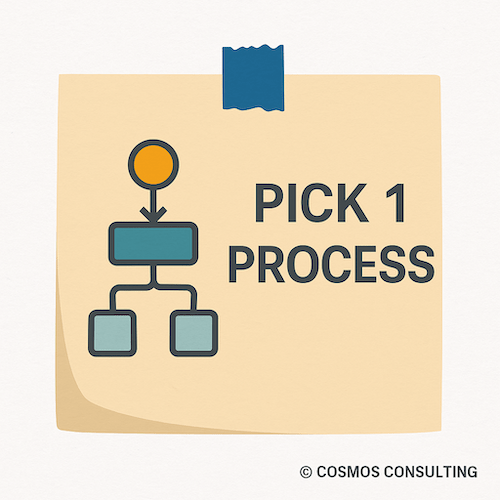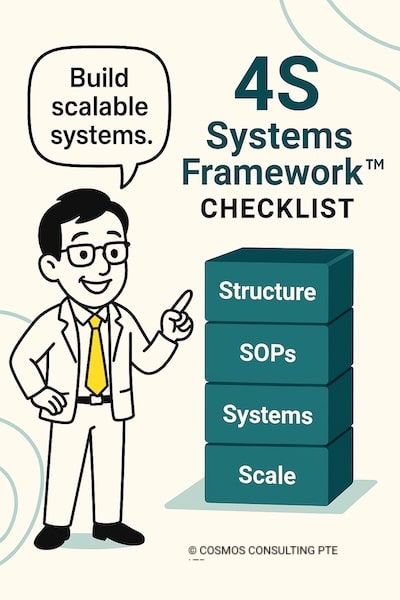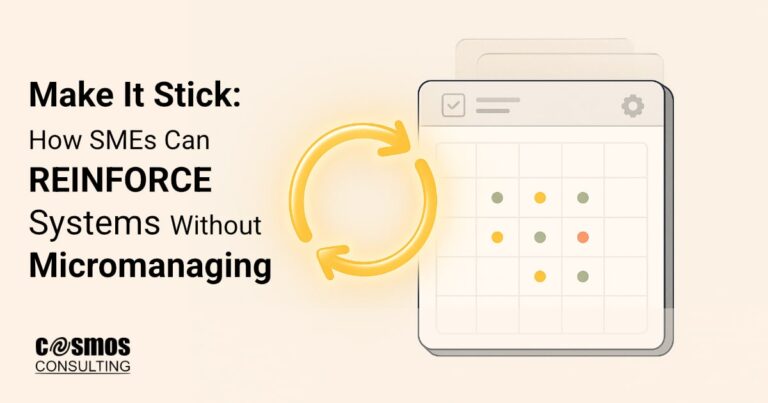👋 Introduction
We have already explored the real reason many SMEs hit growth ceilings: a leadership bottleneck.
But let us bring this closer to the ground:
- 📌 Do team members pause until the MD gives the green light?
- 🧠 Is there only one person who knows how certain things are done?
- ⏳ Does everything feel urgent — and somehow always end up on one desk?
If any of this sounds familiar, it’s not unusual.
In our last post, we unpacked why well-meaning leaders unintentionally stall progress.
This blog picks up from there and shifts into action – SME Bottleneck Solutions.
SME Bottleneck Solutions
Here are five practical, no-fluff steps to help SMEs move from bottlenecked to streamlined operations – where the teams have clarity, ownership, and space to move without constant supervision.

Step 1: Identify One Process That Constantly Gets Stuck
There is no need to fix the entire business in one go: neither is it possible, nor advisable. The key is to start small, but start smart.
Begin with one process where things consistently get stuck. For example:
- 🚚 Delivery can’t be released until the MD approves every dispatch.
- 📝 Proposals sit idle until the founder has “had a look”.
- 📋 Onboarding new clients stalls because only one person knows the flow

This pilot process becomes the proof of concept. Once it moves smoothly, momentum follows.
🧠 Insight: Addressing workflow bottlenecks is one of the fastest ways to unlock capacity at scale, a truth echoed across multiple industry studies, including insights from McKinsey and BCG.
Step 2: Document the Steps (Even If It’s Rough)
🧾 Capture the process in plain language. It is not about polish, it is about clarity.
Subordinates often hesitate to ask about even the most basic steps, not because they don’t care, but because they fear looking incompetent. That hesitation leads to slowdowns, errors, and delays.
Clear documentation solves this. Even if it starts out rough, a simple SOP gives teams permission to act confidently. It removes guesswork and builds a culture where following the system is the default, not the exception.
What happens, in what order, and who’s responsible at each step?
- ✍️ Start with bullets or a quick voice note
- ❓ Include the “obvious”, it is often not obvious to others
- 🎯 Identify decision points and who owns them
Often, the root of bottlenecks lies in unspoken knowledge or undefined roles.
💡 Tip: Use our SOP Starter Kit to structure your first process.
Step 3: Define Clear Ownership and Let It Go
Once the process is documented, the next move is to assign full ownership, not partial involvement, but real decision-making power.
Here is what that looks like in practice:
- 🏭 In one manufacturing SME, the stores team now dispatches any order below USD 1,500 without waiting for the owner’s approval.
- 💼 In a services firm, the ops coordinator issues client proposals using an approved template; no back-and-forth needed.
These changes didn’t happen by chance:
- 📋 Proper processes were documented
- 🧑🏫 Training was provided
- 🧰 Tools were handed over
That is what made it possible to eliminate the need for approvals at every step. These are not just small wins. They signal that the system is trusted.
Ownership builds capability. And with that, trust grows in both directions.
➡️ This step focuses on internal alignment, getting the right person trained and equipped to own the process fully. But ownership alone is not enough. The next step ensures the whole team understands and supports the shift.
To keep it safe and smart, define two simple boundaries:
- ✅ What decisions can be made independently?
- 🚦 When should things be escalated?
🔎 Further Reading: HBR: 5 Strategies to Empower Employees to Make Decisions – a clear reminder that autonomy is key to trust, capability, and team commitment.
Step 4: Add a Simple Check or Dashboard
Delegating does not mean disconnecting. The smartest SMEs build in lightweight review points, not to control, but to stay aligned.
Some examples that work well:
- 📆 A weekly snapshot of key operations
- 📈 A shared dashboard showing delays, errors, or completion rates
- 🗓 A 15-minute ops review call (held consistently, not just when things go wrong)
In one factory, just tracking dispatch turnaround times weekly helped reduce bottlenecks by 30%. In a consulting team, listing client onboarding status in a shared sheet gave instant visibility, no chasing needed.

These controls don’t create extra work; they protect flow, without adding friction.
Step 5: Communicate the Change Clearly
Even the best process would not land unless the team knows it is real and here to stay.
That means clarity, consistency, and public reinforcement. Once the shift is made:
- 🙋 Announce who owns the process now and what they are responsible for – Structure
- 🚫 Be explicit about what no longer needs approval or escalation – Reassign
- 🔁 Reinforce that this is not a one-time test, this is the new normal.
In one SME, a simple Slack message pinned to the team channel made it clear: “Dispatches under USD 1,500 no longer require MD sign-off. Please follow the updated flow chart.”
Small signals like that do two things:
📌 Build trust in the new system
🧭 Guide behavior without micromanagement
Teams won’t follow a system unless they believe it will be consistently enforced.
📍 Tip: Post the checklist or flow in the team chat, on a whiteboard, or wherever it stays visible and referenced.
Reflective Takeaway
Operational freedom doesn’t come from complexity; it starts with one smart shift, made deliberately and consistently.
The less your operations depend on a single point of control, the more they are set up to scale, without burning out the people at the center.
Whether it is a two-person service outfit or a 20-person manufacturing floor, these first five steps shift operations from founder-reliant to functionally scalable.
Let us Talk
💬 What is one task or process that keeps circling back to the top unnecessarily?
That moment of frustration, the one that makes everyone wait, is often the best place to start.
👇 Share your experience in the comments. Let us crowdsource some smart fixes.
📥 And if you are ready to take action: download the Free SOP Starter Kit from the COSMOS Vault to document your first clean handover or download the 4S Checklist as a step towards finding SME bottleneck solutions.

4S Checklist
A practical self-check to spot bottlenecks and strengthen your SME systems with Structure, SOPs, and visibility. Built from the 4S Framework blog




